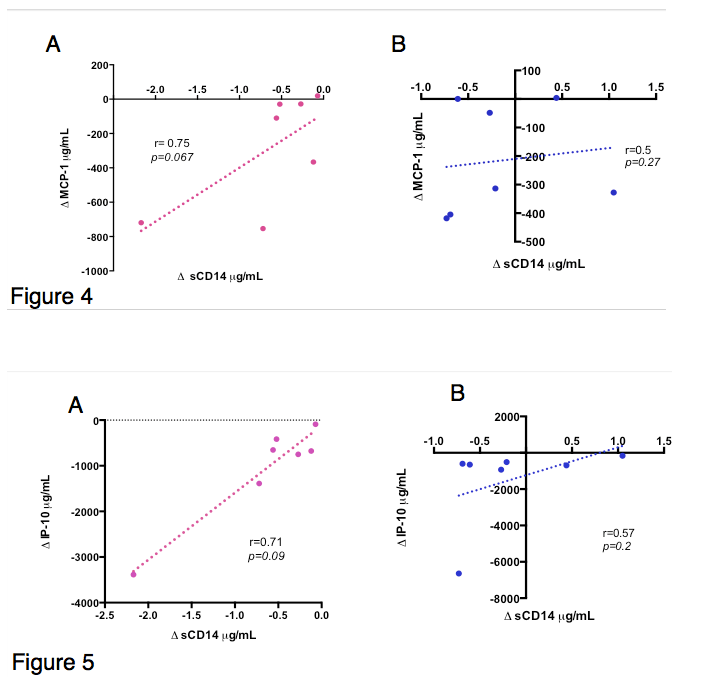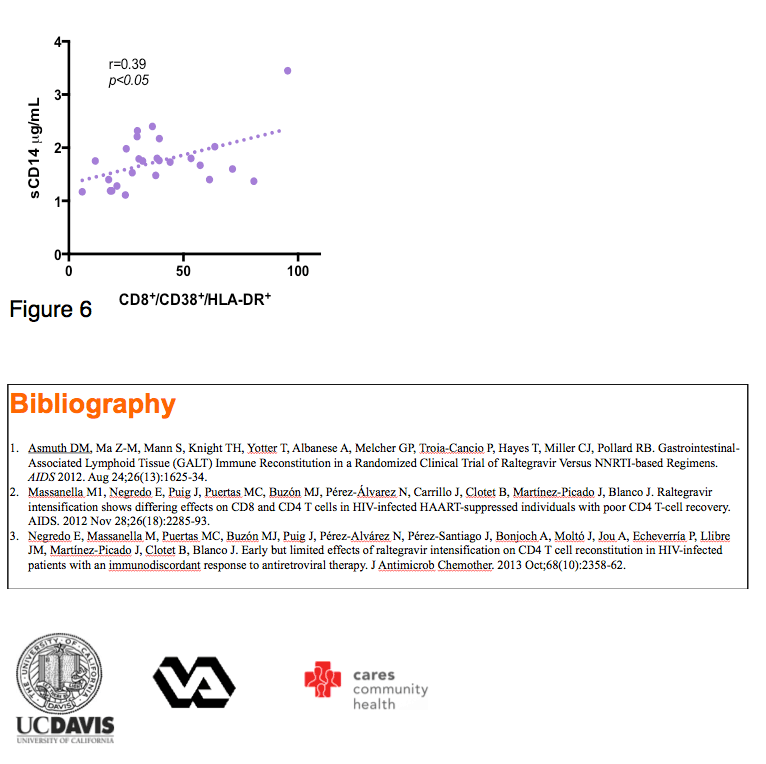 |
 |
 |
| |
Raltegravir May Offer Gut Microbe Advantages Compared With Nonnucleosides
|
| |
| |
20th International AIDS Conference, July 20-25, 2014, Melbourne
Mark Mascolini
Taking a first-line raltegravir regimen improved markers of immune cell activation and microbial translocation compared with starting a nonnucleoside (NNRTI)-based regimen, according to a study of 9-month biomarker changes among 16 people in a randomized US study of microbial translocation [1]. The researchers believe results suggest that raltegravir improves the mucosal barrier or shifts microbial communities more than NNRTIs in people starting their first regimen.
Recent research identified microbial translocation--passage of microbes from the gut to other sites such as lymph nodes, liver, and spleen--as a cause of ongoing systemic immune activation in people responding to antiretroviral therapy [2]. Prior work by US investigators charted a significant drop in microbial translocation (as indicated by sCD14 levels) in people randomized to raltegravir but not to one of three NNRTIs [3]. Other research found reduced immune activation in people taking raltegravir [4,5]. To determine why raltegravir reduces immune activation and microbial translation, the US team further analyzed findings in the raltegravir/NNRTI study.
Study participants underwent upper endoscopy for duodenal biopsies when entering the trial and after 9 months of therapy. The researchers measured levels of markers indicating monocyte/lymphocyte activation (IP-10, MCP-1, IL-4) and microbial translocation (sCD14, lipopolysaccharide-binding protein-1 [LBP-1], and bactericidal/permeability increasing protein [BPI]).
The investigators explained that lipopolysaccharide potently stimulates immune activation and promotes monocyte activation. IL-4 induces differentiation of naive T cells and has been linked to chronic inflammation and wound repair by stimulating TGF-beta secretion. Produced by monocytes, endothelial cells, and fibroblasts, IL-10 plays a role in monocyte activation. MCP-1 is secreted by monocytes, macrophages, and dendritic cells to increase monocyte movement.
The study began with 25 antiretroviral-naive people, 16 of whom completed the trial, including 7 who took raltegravir and 9 who took an NNRTI chosen by clinicians (4 efavirenz, 3 nevirapine, 2 etravirine). All study participants reached an undetectable viral load.
Two people in the raltegravir group and 1 in the NNRTI group were women. Median age stood at 45 in the raltegravir group and 37 in the NNRTI group. Median pre-ART CD4 counts were in the low 300s in both HIV groups, while median pre-ART viral load stood at 117,600 copies in the raltegravir group and 26,200 copies in the NNRTI group.
Both sCD14 and LBP-1 dropped significantly in people taking raltegravir but not an NNRTI, findings reflecting decreased microbial translocation with raltegravir but not with NNRTIs. Falling sCD14 with raltegravir (but not with NNRTIs) correlated with declines in IL-4 (r = 0.78), MCP-1 (r = 0.75), and IP-10 (r = 0.71).
Levels of IP-10, IL-4, and MCP-1 dropped significantly in both treatment groups, while BPI did not change significantly in either group. CD8-cell activation correlated with sCD14 change at 9 months in both groups, a finding confirming the impact of microbial translocation on immune activation in people taking antiretrovirals.
Taken together, the researchers proposed, the findings suggest raltegravir improves the mucosal immune barrier or shifts microbial communities, which could lead to reduced immune activation in raltegravir-treated people.
References
1. Asmuth DM, Ma ZM, Hayes T, et al. Raltegravir (RAL) therapy is associated with reduced microbial translocation (MT) and monocyte activation in HIV infected subjects na•ve to antiretroviral therapy (ART). AIDS 2014. 20th International AIDS Conference. July 20-25, 2014. Melbourne. Abstract WEPE013.
2. Brenchley JM, Price DA, Schacker TW, et al. Microbial translocation is a cause of systemic immune activation in chronic HIV infection. Nat Med. 2006;12:1365-1371. http://www.ncbi.nlm.nih.gov/pubmed/17115046
3. Asmuth DM, Ma ZM, Mann S, et al. Gastrointestinal-associated lymphoid tissue (GALT) immune reconstitution in a randomized clinical trial of raltegravir versus NNRTI-based regimens. AIDS 2012;26:1625-1634. http://journals.lww.com/aidsonline/Fulltext/2012/08240/Gastrointestinal_associated_lymphoid_tissue_immune.5.aspx
4. Massanella M, Negredo E, Puig J et al. Raltegravir intensification shows differing effects on CD8 and CD4 T cells in HIV-infected HAART-suppressed individuals with poor CD4 T-cell recovery. AIDS. 2012;26:2285-2293.
5. Negredo E, Massanella M, Puertas MC, et al. Early but limited effects of raltegravir intensification on CD4 T cell reconstitution in HIV-infected patients with an immunodiscordant response to antiretroviral therapy. J Antimicrob Chemother. 2013;68:2358-2362.
----------------------

D.M. Asmuth1, Z.-M. Ma2,3, S. Mann1, A. Albanese4, P. Troia-Cancio1,5, G.P. Melcher1, T. Yotter1, C. Blakenship3, R.B. Pollard3, and C.J. Miller2,3
1University of California Davis Medical Center, Sacramento, CA, 2Center for Comparative Medicine, Davis, CA, United States, 3University of California Davis, Davis, CA,
United States, 4Veterans Administration Northern California Health Care System, Sacramento, CA, United States, 5CARES Community Health, Sacramento, CA, United States







|
| |
|
 |
 |
|
|